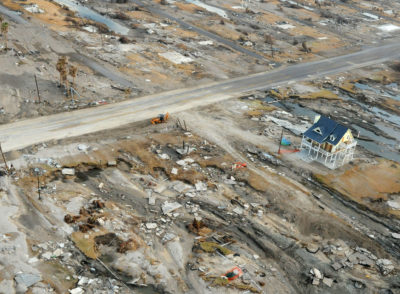Damage along the Bolivar Peninsula in Texas from Hurricane Ike in September 2008. Jocelyn Augusitno/FEMA
In the aftermath of major coastal storms, the mantra to “build back better” is often touted repeatedly in rebuilding strategies, with promises to construct resilient houses more capable of surviving the next storm. But a new study of five American coastal communities finds that homes are actually being built back bigger, not better, after catastrophic weather events, dwarfing the structures that were lost.
This trend of “building back bigger… creates an intensification of coastal risk — through increased, high-value property being exposed to major damage or destruction,” coastal scientist Eli Lazarus of the University of Southampton in the UK, lead author of the new study, said in a statement.
Lazarus and his colleagues used satellite images from before and after six major hurricanes that struck the U.S. Atlantic and Gulf Coasts between 2003 and 2012 to measure changes in residential building footprints. They examined rebuilding trends in Mantoloking, New Jersey; Hatteras and Frisco, North Carolina; Santa Rosa Island, Florida; Dauphin Island, Alabama; and Bolivar, Texas — all of which are barrier islands comprised mainly of single-family residential buildings.
Buildings devastated by hurricanes were rebuilt between 19 and 49 percent larger, according to the study, published in the journal Nature Sustainability. New homes constructed post-hurricane (i.e. not replacements for existing buildings) exceeded the footprints of other pre-storm buildings in the area by as much as 55 percent.
Home sizes across the United States have been increasing in general, but Lazarus and his colleagues argue that their findings point to a specific post-disaster trend with ramifications larger than just an individual homeowner’s choice of how to rebuild.
“The risk of some choices you make is not entirely yours, it’s distributed to other people,” he told Popular Science, referring to U.S. taxpayer-funded programs like the National Flood Insurance Program and FEMA emergency disaster relief. As a result, every taxpayer is inadvertently “supporting development in risky places,” he says.
The findings are also indicative of how middle- and low-income families are increasingly being displaced from coastal communities. Following disaster, many of these homeowners cannot afford to rebuild, opening up prime oceanfront property to developers of luxury homes — structures that will cost taxpayers even more if disaster strikes again.



